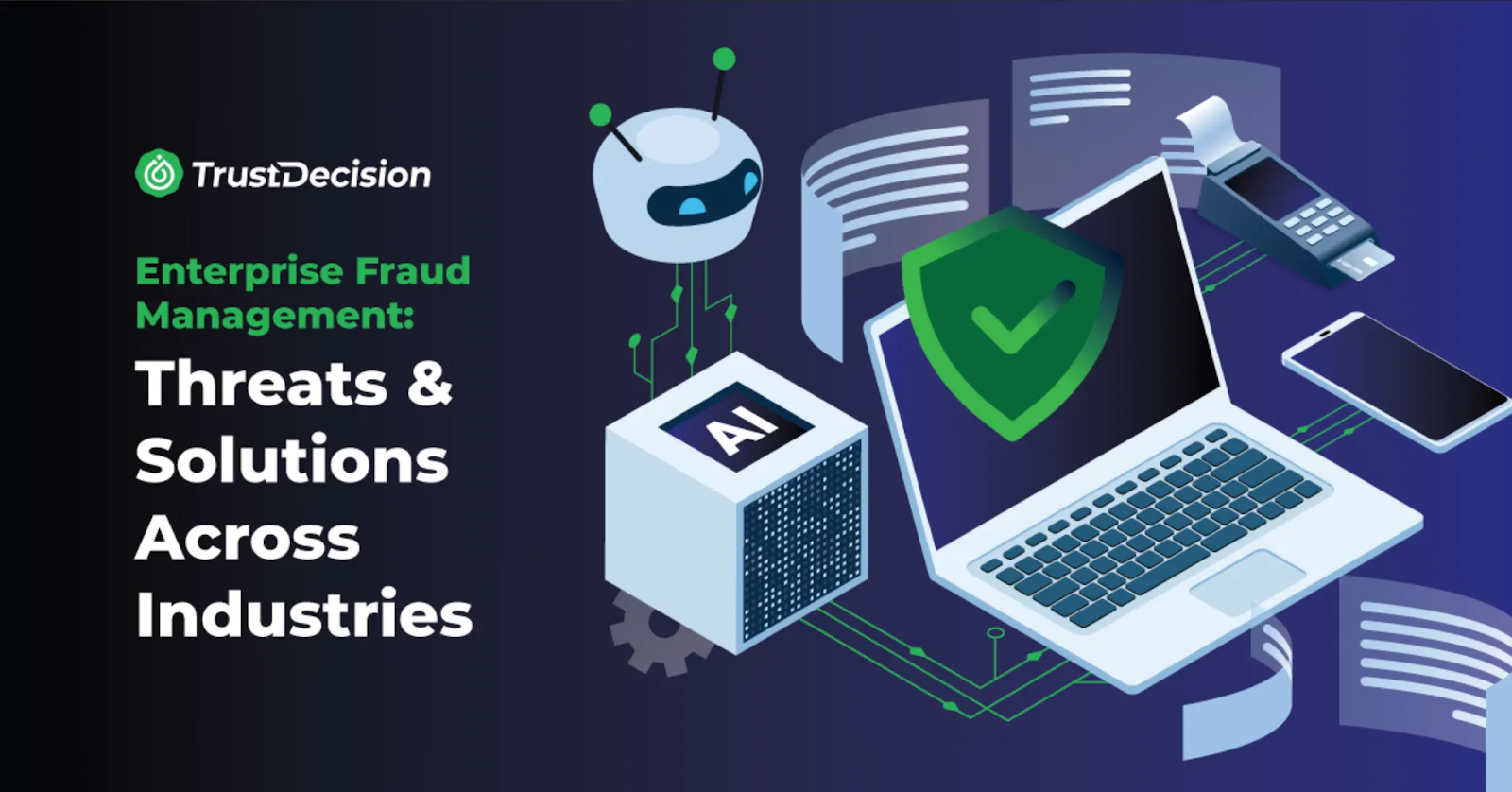Enterprise Fraud Management: Threats & Solutions For Industries
Learn enterprise fraud management strategies combining AI, behavioral analytics & real-time detection. Reduce fraud losses across all channels.

October 27, 2025
7 minutes
Learn enterprise fraud management strategies combining AI, behavioral analytics & real-time detection. Reduce fraud losses across all channels.

October 27, 2025
7 minutes



Digital transformation has created unprecedented fraud vulnerabilities, with organizations facing $5.1 trillion in annual losses as sophisticated criminals exploit gaps in traditional, disconnected detection systems.
Enterprise Fraud Management (EFM) represents the evolution from reactive point solutions to unified, AI-driven fraud prevention. By integrating machine learning, behavioral analytics, and device intelligence across all customer touchpoints, EFM delivers real-time protection while maintaining seamless customer experiences.
This guide provides practical implementation strategies, real-world case studies, and proven methodologies for building effective EFM systems across banking, e-commerce, fintech, and other high-risk industries.
Enterprise Fraud Management is a unified, AI-driven platform that prevents fraud across all customer touchpoints in real-time. Unlike traditional point solutions that operate in isolation, EFM creates a centralized intelligence system that correlates signals from websites, mobile applications, call centers, and physical locations to identify sophisticated fraud patterns.
Key Differentiators:
Automated Response: Instant blocking, authentication, and approval with minimal manual intervention
The fundamental advantage lies in EFM's ability to see the complete fraud picture—when a payment method is flagged in one channel, it's immediately restricted across all systems, preventing criminals from exploiting channel gaps.
EFM detects payment fraud, account takeover, application fraud, promotion abuse, money laundering, and automated bot attacks across all channels simultaneously.
Traditional systems operate in channel silos with high false positive rates and reactive detection. EFM provides unified cross-channel intelligence, significantly reducing false positives and preventing fraud before it occurs through real-time correlation across all touchpoints.
EFM focuses on three core operational pillars:
Implementing an EFM solution provides significant benefits, from reducing fraud losses to enhancing operational efficiency and customer experience.
Together, these comprehensive benefits illustrate how EFM not only safeguards your organization's financial health but also optimizes operations and fosters customer trust. Such robust, multi-faceted protection is more critical than ever, especially when considering the sophisticated and rapidly changing threats.
According to the Accenture 2024 AI ROI Report study, most enterprises recover their investment in EFM platforms within 12–18 months, driven by fraud loss reduction, automation of manual reviews, and operational efficiency. Some organizations reported ROI payback in under 6 months.
Advanced behavioral analytics establish individual user baselines, learning normal patterns for each customer. Adaptive thresholding mechanisms adjust dynamically based on real-time feedback, distinguishing legitimate unusual behavior from actual fraud attempts.
Learn more about Reducing False Positive/Negative in Fraud Management
Built-in compliance modules include pre-configured templates for AML, PCI-DSS, GDPR, and PSD2. Automated audit trails, data lineage, and real-time monitoring ensure continuous compliance with reduced administrative overhead.
Privacy-by-design principles with advanced encryption, anonymization, and granular access controls. Fraud detection is achieved without exposing individual details, utilizing pseudonymization and differential privacy while ensuring GDPR and CCPA compliance.
Modern fraud operations have evolved into sophisticated enterprises employing advanced technologies and coordinated strategies. Criminal organizations now utilize:
The proliferation of digital payment methods, including mobile wallets, buy-now-pay-later services, and peer-to-peer platforms, has exponentially increased potential attack vectors. Research demonstrates that organizations implementing comprehensive fraud management programs experience 42% lower fraud losses compared to those relying on legacy detection methods, underscoring the critical importance of modernizing fraud prevention strategies.
Elastic scaling with Kubernetes-based orchestration automatically allocates resources during traffic surges, maintaining sub-second performance through dynamic microservices scaling based on demand.
EFM analyzes transaction data, device intelligence, behavioral biometrics, identity attributes, third-party threat intelligence, and historical patterns simultaneously for comprehensive risk assessment.
Yes, API-first architecture with RESTful and GraphQL APIs enables seamless integration. Modular microservices allow gradual replacement of legacy systems while maintaining current operations.
These capabilities work cohesively to create a unified defense system that adapts to emerging threats while maintaining operational efficiency and ensuring that legitimate customer transactions proceed without unnecessary friction.
Choosing the right enterprise fraud management solution is crucial for robust fraud prevention. This section outlines the key features and performance benchmarks to consider when evaluating and selecting a platform that aligns with your organization's specific needs and security requirements.
✓ Unified Multi-Channel Risk Scoring
✓ Advanced Machine Learning Capabilities
✓ Comprehensive Integration
✓ Efficient Case Management
✓ Built-in Compliance
Modern EFM platforms can be deployed within days, utilizing API-first, cloud-native architecture. Organizations typically see initial results within 4-6 weeks, with full enterprise implementation completed in 12-24 weeks through phased, modular deployment.
Ready to make an informed decision? Contact us today!
The landscape of fraud is constantly evolving, demanding continuous adaptation from businesses. Here are key emerging trends and technological advancements shaping the future of EFM, from sophisticated analytical techniques to collaborative intelligence sharing.
Graph analytics and machine reasoning technologies are becoming increasingly important as fraud networks grow more sophisticated. These systems model relationships between users, devices, accounts, and transactions to identify coordinated fraud operations that span multiple organizations and geographic regions.
Synthetic identity fraud continues to evolve as criminals develop more sophisticated methods of blending legitimate and fabricated information. As deepfake technology advances, EFM platforms are integrating sophisticated detection algorithms that identify subtle artifacts in synthetic media, protecting video-based identity verification processes.
Industry consortiums and federated learning enable organizations to share anonymized threat intelligence while maintaining data privacy, rapidly disseminating emerging fraud patterns across sectors.
Enterprise fraud management has evolved from an optional security enhancement to a business-critical necessity in today's digital ecosystem. To build a robust and future-proof defense, organizations need solutions that offer adaptability and advanced capabilities.
TrustDecision's EFM platform empowers this journey by integrating data ingestion, real-time machine learning decisioning, behavioral analytics, and case management within a cloud-native framework. This delivers industry-leading fraud prevention while maintaining optimal user experiences, helping you take decisive action against evolving threats.
In today's dynamic digital landscape, enterprise fraud management stands as a fundamental pillar for business resilience and growth. Organizations that proactively implement comprehensive EFM strategies gain a powerful advantage, significantly reducing fraud losses while simultaneously enhancing customer experiences and boosting overall operational efficiency.
Key Success Factors:
Ready to get started?
The threat landscape continues to evolve, but you don't have to face it alone. TrustDecision's Enterprise Fraud Management platform provides the advanced protection your organization needs to stay ahead of sophisticated fraud attacks.
TrustDecision AI-based Fraud Management platform offers centralized data intelligence processing 120+ billion assessments annually, sub-50ms ML inference, automated cross-channel response orchestration, and proven protection across banking, fintech, e-commerce, and travel industries.
Take the Next Step:
Schedule a Demo - See TrustDecision's EFM platform in action with a personalized demonstration tailored to your industry and use cases.
Let’s chat!
Let us get to know your business needs, and answer any questions you may have about us. Then, we’ll help you find a solution that suits you